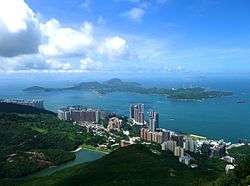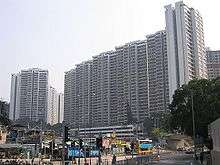Pok Fu Lam
Pok Fu Lam or Pokfulam (Cantonese pronunciation: [pɔ̀ːk̚ fȕː lɐ̏m]) is a residential area on Hong Kong Island, at the western end of the Southern District. It is a valley between Victoria Peak and Mount Kellett, around Telegraph Bay.
| Pok Fu Lam | |||||||||||||||
|---|---|---|---|---|---|---|---|---|---|---|---|---|---|---|---|
 Overlooking Pok Fu Lam and Lamma Island from High West | |||||||||||||||
| Chinese | 薄扶林 | ||||||||||||||
| Cantonese Yale | Bohkfùhlàhm | ||||||||||||||
| Literal meaning | "Thin Shielding Forest" | ||||||||||||||
| |||||||||||||||
Pok Fu Lam can claim several firsts in the history of Hong Kong: It was the place where Hong Kong's floral emblem, Bauhinia blakeana, was first discovered; the site for Hong Kong's first reservoir, Pokfulam Reservoir (1883, now part of a country park), and the site for Hong Kong's first dairy farm by five investors, including Sir Patrick Manson in 1885. The farm supplied not only milk, but cattle to Hong Kong, and later became Dairy Farm. However, it no longer exists in Pok Fu Lam.
Pok Fu Lam is connected to Lung Fu Shan, Sai Ying Pun and Aberdeen by the Pok Fu Lam Road. It's also indirectly connected to the Mid-Levels. Pok Fu Lam also outlooks Lamma Island. Pok Fu Lam is connected to Kennedy Town via Smithfield and Shek Tong Tsui via Hill Road.
Sights
While the farm no longer exists, its remains and other colonial era institutions continue to exist serving, in some cases, other purposes. The former dairy farm can still be seen in the grassy slopes of the hills, but mainly in the two milking sheds that remain. They are between the new Vocational Training Center and the much older Béthanie. Béthanie and the cow sheds are presently administered by the Hong Kong Academy for Performing Arts, but were previously controlled by the University of Hong Kong which used Béthanie as headquarters for the HKU Press. The APA uses Béthanie and the cow sheds for various educational purposes, but also lends the chapel in Béthanie to St. John's Cathedral (Anglican) as the locale for Emmanuel Church - Pokfulam, a daughter (subordinate) church serving the west of Hong Kong Island.
Béthanie was built as a sanatorium between 1873 and 1875 for the French Catholic missionaries in China, better known as Missions Etrangères de Paris or MEP. Recently restored with loving care, Béthanie is now used by the Academy for the Performing Arts for educational purposes. Béthanie includes a small chapel. In its present restored configuration, this chapel seats about 100 and is used each Sunday by Emmanuel Church - Pokfulam, a daughter church of St. John's Cathedral. The Béthanie chapel is a beautiful Neo Gothic structure. Some of the original statuary and stained glass windows have been recovered and re-installed.[1]
Across the Pokfulam Road, is University Hall. U-Hall, as it is abbreviated, is a residential unit for undergraduates of the University of Hong Kong. Originally, U-Hall was the residence of a merchant, but eventually, it came under the control of the same French Catholic missionaries who built Béthanie. It was extended greatly and printed religious literature in its basement in many languages for nearly 100 years. In the 1950s, when missionary work in China died, the building was given to the HK government which gave it to the University of Hong Kong as a student residential unit. It is smaller now than it used to be, but still houses 100 or so undergraduates. There was a chapel in the building: it now serves as the dining hall for the students. University Hall is much in demand as a location for movies, wedding photos, advertisements, and other purposes.
Village
At the centre of Pok Fu Lam is an indigenous village, the Pok Fu Lam Village (薄扶林村), the only one of its kind remaining on Hong Kong Island. Often mistaken as a shanty town by the residents of the surrounding apartments, the conservation value of the village has been acknowledged by its inclusion on the 2014 World Monuments Watch by the World Monuments Fund.[2]
History
Pok Fu Lam Village is a historic village, which has existed since the beginning of the 17th century. Local residents in the past have repeatedly asked the government to give indigenous inhabitants of Pok Fu Lam the same recognition as residents of the New Territories. These claims have been rejected by the government which also threatened demolition of the village.
In the Kangxi period (late 17th century) of the Qing dynasty, approximately 2,000 people seeking asylum from turmoils in mainland China reached this village. The early villagers, mostly with the surnames of Chen, Huang, and Luo, were farmers. The "Xinan County Journal" of 1819 mentioned that Pok Fu Lam Village was one of three villages on Hong Kong Island (the other were at Stanley and Wong Chuk Hang). It was described as "built alongside the hill and the creek, its structures are quite elegant". After the Second World War, the massive refugee influx seeking asylum from mainland China reached Hong Kong, resulting in the village population increasing from 20-odd households to more than 100 households. The original vegetable gardens were replaced by houses. It was not until the 1980s, when the Hong Kong economy experienced rapid growth, that the village population began to decrease, but many villagers remain in the village today.
Fire Dragon Festival
The villagers have their own festivals: the annual Fire Dragon Dance, the oldest of its kind in Hong Kong, is held during the Mid-Autumn Festival, and is organised entirely by the villagers, who strive to preserve the unique festival for the generations to come. Ng Kong-kin, master craftsman of the 73.3 metre long dragon, has been making these creatures for more than four decades, and continues to volunteer his time building the enormous beast every year; his brother Ng Kong-nan, supervises the training of the dancers and preparation for the annual celebrations. All villagers participate in the burning of incense and each household is blessed by the dragons as they dance through the village, making the festival a fundamental part of the village life. Many other less well known festivals include Bou Chun Tin, which commemorates Nüwa repairing the Wall of Heaven; Fa San Fuk, a ritual carried out on Lunar New Year's Eve for good fortune throughout the year; and Jip Nin Gang, when villagers calculate the best time in Chinese feng shui to welcome the new year, and prepare celebratory procedures for the particular moment.
Buildings
The forest village is divided into three parts: Middle is "Wai Chai", Northern portion is "the vegetable garden", the village tail is "Long Tzutu". There are few types of village house. Some are made of stone and hay with Chinese tiled pitched roof. Some Chinese tiled pitched roof had been replaced with galvanised steel roof. Some village houses are made of brick with concrete flate roof or galvanised steel roofs. In addition the village has characteristic towers, named Li Ling Divine Pagoda, is approximately 5 meters high. The existing pagoda was rebuilt in 1916. The first pagoda was built of stone as advised by the elder villagers.
Housing estates

Pok Fu Lam is notable for its quiet, green living environment (by Hong Kong standard), attracting a significant number of expatriates, many of whom work at the nearby University of Hong Kong. Several private housing estates are located in Pok Fu Lam.
- Chi Fu Fa Yuen (置富花園) was developed in the mid-seventies by Hongkong Land. It comprises 20 towers of 28-storey high-rise buildings with a total of 4,258 residential units and 7 towers of 5-storey villa type low-rise buildings with 70 household units.[3]
- Pokfulam Gardens
- Baguio Villa
Education
- German Swiss International School maintains a campus in Pok Fu Lam.[4]
- Kellett School has a preparatory campus in Pok Fu Lam.[5]
- Ebenezer School & Home for the Visually Impaired is located in Pok Fu Lam.
Hospital
See also
- Cyberport
- Sandy Bay
- Pok Fu Lam Fire Dragon Dance
- List of buildings, sites, and areas in Hong Kong
References
- Emmanuel Church, Pofulam - restoration of Béthanie
- Pokfulam Village World Monuments Fund
- Chan, Chi-kau, Johnnie Casire, "Community development and management of private sector housing estates in Hong Kong" Archived 2013-10-24 at the Wayback Machine, University of Hong Kong, August 1995
- "Campuses." German Swiss International School. Retrieved on February 10, 2017.
- "Our Campuses." Kellett School. Retrieved on June 11th, 2017.
External links
| Wikimedia Commons has media related to Pok Fu Lam. |
- Article about the Bethanie
- Pokfulam Village Website on the village, including festivals.